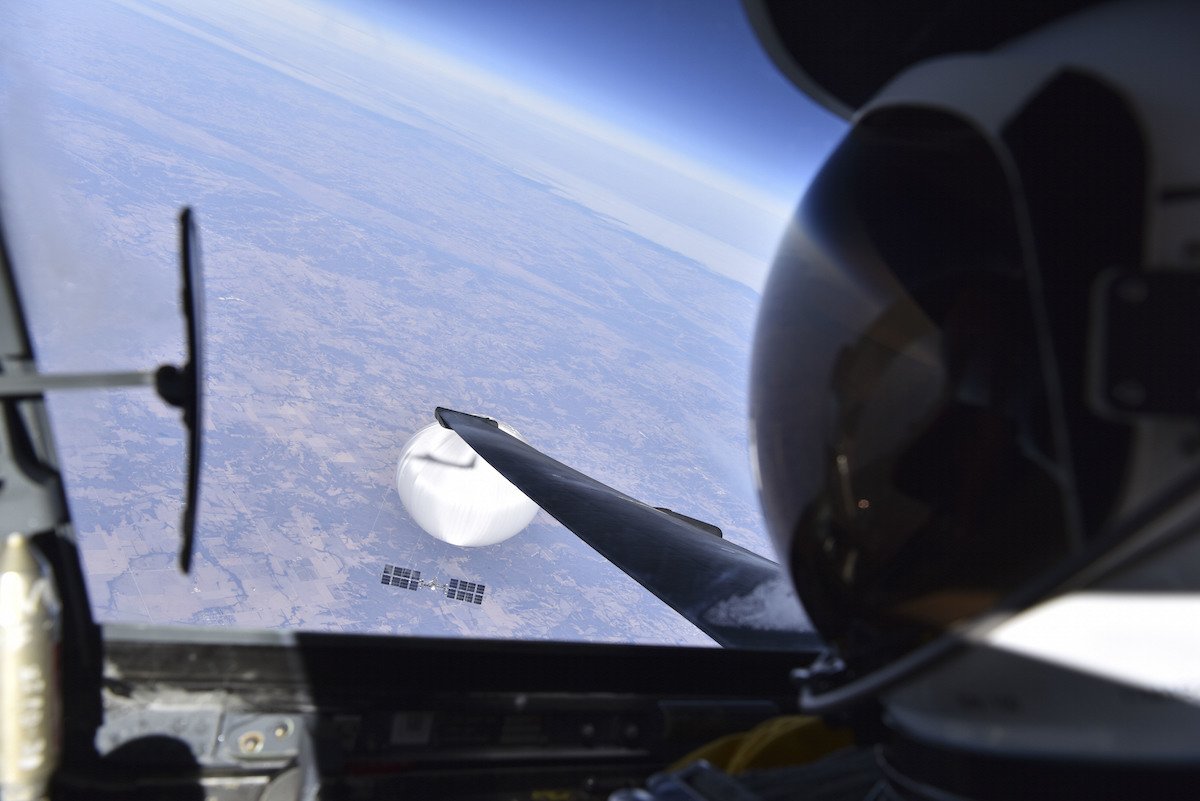
The pilot of a U-2 spy plane snapped a selfie while chasing the Chinese spy balloon that crossed the US in early February. Photo published by Air Force amn/nco/snco Facebook page, later released by the Department of Defense.
A U-2 pilot snapped a selfie of themselves during a mission to observe the Chinese reconnaissance balloon that floated across the US in early February.
The picture, which has been rumored to be, er, floating around Air Force intelligence and pilot circles for weeks, shows the pilot’s distinctive helmet, the U-2’s distinctive wing, and, several hundred yards away, the balloon.
The balloon famously floated across much of the US until it was shot down just off the coast of South Carolina on Feb. 4.
The Pentagon officially released the photo after the selfie appeared on social media this week, ending up on the widely read Air Force-centered Facebook page Air Force amn/nco/snco.

A U-2 Dragon Lady flies over the Golden Gate Bridge near San Francisco, California, March 23, 2016. US Air Force photo by Staff Sgt. Robert M. Trujillo.
Though undated, the selfie supports claims by US authorities that the Air Force closely tracked the balloon during its flight.
Operationally, the picture also represents an unprecedented use of the U-2.
The fragile, high-flying spy aircraft was designed in the 1950s to overfly targets far above air defense systems while avoiding interactions with other aircraft at almost any cost. But here the U-2 may have been specifically sent to intercept the balloon, which at 60,000 feet was flying close to twice as high as commercial airliners and most military jets.
The balloon was a Chinese reconnaissance platform, though the nature of its data collection remains largely a mystery.
Its destruction was widely mocked as a sign of weakness of the US military under President Joe Biden. But revelations in the weeks since have revealed that Chinese balloon-spies have been passing over the US since at least the tail end of the Trump administration.

A U-2 Dragon Lady flies over the airfield at Beale Air Force Base, California, April 12, 2018. US Air Force photo by Staff Sgt. Ramon A. Adelan.
The U-2 made flights over Russia in the 1950s to observe Soviet nuclear programs until one was downed by a new generation of Russian anti-aircraft missile in 1960. In 1962, the U-2 took pictures of Russian ballistic missiles deployed in Cuba, both beginning and then, by photographing their removal, ending the Cuban missile crisis.
The U-2 remains operational today, orbiting battlefields and occasionally popping up for domestic missions. In February 2022, a U-2 helped rescue a lost pilot who had made an emergency landing near a remote California mountain lake. The U-2 was on a training mission when the pilot, Maj. Sean Heatherman, heard a cry for help over his radio. From far overhead, Heatherman was able to alert rescuers to the plane’s location.
The U-2 is notoriously difficult to fly. Early versions of the U-2 had to be flown within a 5 mph window, a so-called coffin corner of engineering, where any slower would cause the plane to stall and tumble, while any faster could break the plane apart.
Its massive wings also make it difficult to land. When one of the planes lands, a qualified U-2 pilot chases it down the runway in a car, relaying instructions and information to help the pilot ease the plane down onto its wheels.
Still, the U-2 can buck and twist wildly, as a collection of videos from former U-2 pilot Ross Franquemont makes clear on Instagram.
First flown in 1955, the U-2 is one of the most specialized aircraft ever flown by the Air Force. It flies unarmed and, despite a jet engine, roughly as slow as World War II-era prop-driven planes. Its tiny fuselage is just large enough to carry camera and other recording equipment for spy missions.
But its thin, 50-foot wings allow it to fly above 70,000 feet, far beyond the reach of the surface-to-air missiles of the 1950s and ’60s and even many of today’s fighter planes. The U-2 is said to have a glide ratio — a measure of how far, with the engine off, a plane’s wings allow it to travel before gravity pulls the plane down — of over 25-to-1, a ratio akin to that of gliders. Modern commercial jets, designed 50 years after the U-2, top out between 15-to-1 and 20-to-1.
As a result, if a U-2 were to lose power while at 70,000 feet, it could glide 300 miles to safety.
Read Next: ‘I Just Disobeyed the Order’: The Incredible Story of Capt. Paris Davis’ Medal of Honor

Matt White is a former senior editor for Coffee or Die Magazine. He was a pararescueman in the Air Force and the Alaska Air National Guard for eight years and has more than a decade of experience in daily and magazine journalism.
BRCC and Bad Moon Print Press team up for an exclusive, limited-edition T-shirt design!
BRCC partners with Team Room Design for an exclusive T-shirt release!
Thirty Seconds Out has partnered with BRCC for an exclusive shirt design invoking the God of Winter.
Lucas O'Hara of Grizzly Forge has teamed up with BRCC for a badass, exclusive Shirt Club T-shirt design featuring his most popular knife and tiomahawk.
Coffee or Die sits down with one of the graphic designers behind Black Rifle Coffee's signature look and vibe.
Biden will award the Medal of Honor to a Vietnam War Army helicopter pilot who risked his life to save a reconnaissance team from almost certain death.
Ever wonder how much Jack Mandaville would f*ck sh*t up if he went back in time? The American Revolution didn't even see him coming.
A nearly 200-year-old West Point time capsule that at first appeared to yield little more than dust contains hidden treasure, the US Military Academy said.












